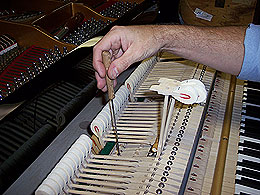 If tuning your piano is like putting gas in you car, then piano regulation is like having the engine tuned up – spark plugs need replacement, timing belts and chains need adjusting, and valves need resetting. And although many cars will run a long time without a tune-up, eventually they just don’t work very well.
If tuning your piano is like putting gas in you car, then piano regulation is like having the engine tuned up – spark plugs need replacement, timing belts and chains need adjusting, and valves need resetting. And although many cars will run a long time without a tune-up, eventually they just don’t work very well.
Like a smooth running car, a piano needs more than just regular tunings to keep the thousands of parts working at their best. Careful and precise adjustments of the various piano parts are known as regulation. A well regulated piano will play and feel much more even and responsive. It will allow you to play soft, pianissimo passages with better control and loud, forte passages more easily with greater power. And most importantly, it will play with more predictability and give the player greater confidence.
To achieve this level of performance demands a piano that is well regulated and inherently capable. All pianos benefit from being well regulated, however, only finer quality pianos really deliver the broad dynamic range and control expected by concert artists.
Does my Piano need Regulation?
Pianos can be quite forgiving when it comes to how far out of regulation they can become and still function. But just functioning, and working at their best are two very different things. As a pianists grows in skill, this difference becomes more and more noticeable and can eventually impede their progress! Better players need better performing instruments in order to continue improving.
If your instrument displays a lack of sensitivity or a decreased dynamic range, it probably needs regulation. If you notice that the keys are no longer level, the touch is uneven, or you are having difficulty playing quick passages or note repetitions, your piano likely needs regulation.
More and more practice will not compensate for an action in need of regulation. Poor legato touch, and gradual loss of subtlety in phrasing may not be your fault – your piano is likely in need of regulation.
How are Pianos Regulated?
Modern pianos have 88 keys. Each of those keys has a series of levers, springs, and flanges that work together to give the pianist the ability to create music. There are literally thousands of working parts inside a piano. All of which are designed to work best when properly regulated to one another.
The process of piano regulation involves following a step-by-step process of aligning parts, adjusting screws, bending springs, raising or lowering levers and other adjustments so that the player can achieve the most power, speed, and control possible for that instrument. It is normal to repeat many of the regulation adjustments several times, with each pass (or cycle) bringing it closer to perfection. It is both tedious and time consuming, but well worth it in most cases.
If you considering having your piano regulated or would like to know more about Piano Regulation, I recommend reading this excellent REGULATION technical bulletin from the Piano Technicians Guild.